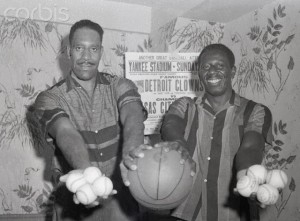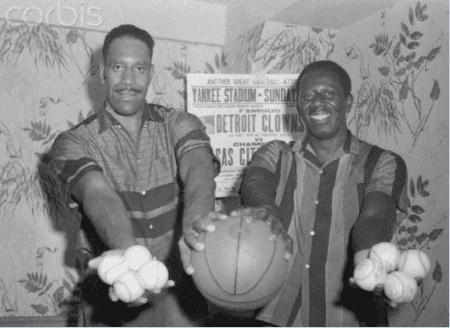
Technically, Nat “Sweetwater” Clifton was the second black player to sign with an NBA team. He was also the first black player to play in the NBA Finals, as well as being the oldest player in NBA history to make an All-Star game debut (at age 34).
Technicalities aside, it should be obvious Clifton’s place in sports history is significant. Basketball, after all, is the world’s second most popular sport primarily because of the exploits of African-American players. There is no Julius Erving, Magic Johnson or Michael Jordan without the efforts of Clifton and his contemporaries.
This is why, come August, Clifton will be inducted into the Naismith Hall of Fame alongside Nolan Richardson. It will surprise some to learn Clifton was born in central Arkansas in the early 1920s and spent the first six years of his life in England, Ark. He and his family then moved to Chicago’s South Side, where he starred in baseball and basketball for DuSable High School. He landed in New Orleans for college, then served three years in the U.S. Army before bouncing around a few pro leagues. He wasn’t exactly a scrub journeyman, though: In 1948, Clifton signed a $10,000 contract to become the world’s highest paid black pro basketball player with the Harlem Globetrotters (which featured fellow Arkansan Goose Tatum, considered by many the greatest Globetrotter ever).
In 1950, he signed with Knicks, where he became one of the franchise’s most popular players and helped lead New York to three Finals appearances. According to the Chicago Tribune, Clifton was primarily a rebounding forward and center, who at 6-foot-6-inch, 200 pounds averaged 10 points and 9 rebounds a game in eight NBA seasons.
A tenacious defender, Mr. Clifton was called on night after night to guard some of the league`s toughest players, including George Mikan, Dolph Schayes and Ed McCauley.
Following his retirement from professional basketball in 1958-seven years before the league instituted a pension plan-Mr. Clifton played two seasons for Globetrotter spinoffs, the Harlem Magicians and the Harlem Americans. After injuring his knee in 1960 while playing with the Magicians, he began driving a Chicago cab.
`I might not be, but I think I`m the best cab driver out there,“Clifton once said. “The way I look at it, if you`re gonna be something, be good at it.’ ‘
Indeed, at age 63, Clifton died of a heart attack at the wheel of his Chicago taxicab.
The story of Sweetwater’s life appears to be adventuresome, inspiring and possibly sad. It’s remarkable he lived in a world – the pro basketball circuit of the late 1940s and 1950s – that as far as I know hasn’t yet been portrayed in a major motion film.
Others have noticed this too. That’s why spring 2015 is the scheduled premiere of “Sweetwater,” a biopic featuring stars such as Nathan Lane, James Caan and Brian Dennehy. The film’s currently in pre-production, and appears like it will exercise some creative license to widen its appeal. As an example of how this could happen, look at this character outline (which is six years old and could have changed in the meantime).
In it, we see Sweetwater has the ambition of the becoming the “Jackie Robinson of basketball” and is disappointed when the distinction of being the first black to play in the NBA goes to Earl Lloyd. I haven’t yet researched Clifton’s life in detail, but I would guess this distinction wasn’t so important to Clifton. For starters, the NBA had just started a few years before and was nowhere near as established as Major League Baseball. At that time, there was no guarantee the NBA would even survive and one day become a league as important and influential as it is now. I could be surprised, though. Obviously, Clifton was a competitive man and Jackie Robinson was still on everybody’s mind.
Another likely history twist: Clifton had a blues-singing white woman lover soon after arriving in New York City . I’m 99% sure this didn’t happen, but injecting this affair and blues singing will definitely help at the box office. Romance or not, I’ll be fascinated to see how the movie actually comes together. I certainly salute its producers for seeing it through despite complications over the last six years.
My goal in the coming months is to learn as much about Clifton’s Arkansas years and family as I can. There’s scant info out there now. It’s been said his grandmother apparently used snuff, and young Nat – who loved sweets – put cocoa in his cheeks to emulate her and get a bit of sugar rush. We know he lived with his mother and an aunt in Chicago, and that’s about it.
It’s unclear what year he was born, although the best guess is 1922. It also appears he was born as “Clifton Nathaniel” so now the task is to find any Nathaniels who used to live around England, Ark. (Lonoke County). If you have any tips, please reach out to me.
More than six decades after he became a pioneer, Sweetwater will again make headlines in the coming year. Help me make sure his life’s full story is told.
***
The above is Part 2 of a series about Chicago and Arkansas sports ties.
***
Learn more about Sweetwater and other Arkansan sports pioneers in my book African-American Athletes in Arkansas: Muhammad Ali’s Tour, Black Razorbacks and Other Forgotten Stories:




Sweetwater is yet another example of the Arkansas Sports Hall of Fame’s failure to recognize early African Americans in sports.